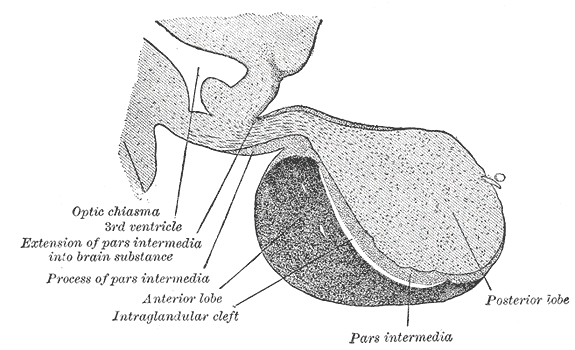
noun Anatomy.
- See under pituitary gland.
noun Anatomy.
- a small, somewhat cherry-shaped double structure attached by a stalk to the base of the brain and constituting the master endocrine gland affecting all hormonal functions in the body, consisting of an anterior region (anterior pituitary or adenohypophysis) that develops embryonically from the roof of the mouth and that secretes growth hormone, LH, FSH, ACTH, TSH, and MSH, a posterior region (posterior pituitary or neurohypophysis) that develops from the back of the forebrain and that secretes the hormones vasopressin and oxytocin, and an intermediate part (pars intermedia), derived from the anterior region but joined to the posterior region, that secretes the hormone MSH in lower vertebrates.
noun
- the master endocrine gland, attached by a stalk to the base of the brain. Its two lobes (the adenohypophysis and neurohypophysis) secrete hormones affecting skeletal growth, development of the sex glands, and the functioning of the other endocrine glandsAlso called: hypophysis, hypophysis cerebri See also adenohypophysis, neurohypophysis
n.
- A small, oval endocrine gland attached to the base of the vertebrate brain and consisting of an anterior and posterior lobe, the secretions of which control the other endocrine glands and influence growth, metabolism, and maturation.hypophysis master gland
- A gland at the base of the brain in vertebrate animals that is divided into two regions, anterior and posterior, each of which secretes important hormones. The anterior portion, whose secretions are directly controlled by the hypothalamus, produces hormones that regulate the function of most of the body’s hormone-producing glands and organs, including the thyroid and adrenal glands. Growth hormone is also produced by the anterior pituitary. The posterior pituitary releases antidiuretic hormone (ADH) and oxytocin.
A small gland, attached to the base of the brain and controlled by the hypothalamus, that functions in the endocrine system. The pituitary gland secretes many hormones: some control the actions of other glands, whereas others influence growth, metabolism, and reproduction.
 Liberal Dictionary English Dictionary
Liberal Dictionary English Dictionary